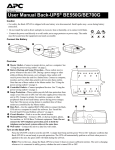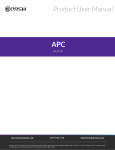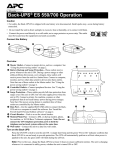Download APC BE750G
Transcript
® ® Back-UPS ES 750 User’s Guide w w w.apc.com Connect Battery 1 For safety, the Back-UPS ES is shipped with one battery wire disconnected. The UPS will not operate until the wire is connected to the touch-safe battery terminal. NOTE: Small sparks may occur during battery connection. This is normal. Insert the battery back into the compartment. Slide the Connect the battery wire firmly to the battery terminal. Turn the Back-UPS ES over and press in the release tab. plastic battery cover back in place until the tab locks. Slide the plastic battery cover off the unit. 3 2 1 BatteryCover Battery Terminals Release Tab Battery Wires Connect Equipment 2 Battery Back-up + Master/Controlled Outlets Surge Protection These outlets are powered whenever the Back-UPS ES is switched ON. During a power outage or other utility problems (brownouts, over-voltages), these outlets will be powered for a limited time by the Back-UPS ES. Plug your computer, monitor, CD-ROM drive and one other data-sensitive device such as an external disk or tape drive, or Home Phoneline Networking Association (HPNA) device into these outlets. Master Battery Backup+ Surge Protection Idle peripheral devices (printer/scanners, speakers) continue to draw power when not in use. To conserve power, the Back-UPS uses “master controlled outlets”. The Master outlet senses when the master device (computer) that is plugged into the Master outlet is no longer drawing current, and automatically shuts off power to the Controlled outlets. Pressing the MASTER ENABLE button for one second enables and disables this feature. When enabled, the green MASTER ENABLE LED is lit (on). When it is disabled, the LED is not lit (off). The Back-UPS ships with MASTER ENABLE activated. Note: Do not connect peripherals to the Controlled Outlets if you want them to continue to run when your computer is turned off. Threshold Programming When the computer is turned off, the Master outlet shuts off power to the Controlled outlets. However, when the computer goes into “hibernation (sleep) mode” the Master outlet may not properly recognize the reduced power level. To ensure the Master outlet shuts off power to the Controlled outlets properly, the threshold setting may need to be adjusted from the “default value”. If the peripherals plugged into the Controlled outlets do not turn off when the computer goes into hibernation mode, first ensure the MASTER ENABLE LED is lit, and if so, then perform the procedure provided below to switch the threshold setting to High. Conversely, if the computer has an extremely low power level, it may require that the threshold setting be set to Low if the Controlled outlets automatically shut off, even when the computer is running. The Back-UPS automatically exits this mode in five seconds if no buttons are pushed, or no operations are run. The three threshold settings that can be selected are summarized in the table below. Indicators Flashing Surge Protection Controlled by Master Surge Protection Threshold Setting Input Wattage Range (Hibernation Mode) 1. Master Enable LED Low 10 Watts 2. Master Enable LED, On Line LED Medium (default) 25 Watts 3. Master Enable, On Line, Replace Battery LEDs High 60 Watts Perform the following steps to change the threshold settings: These outlets provide full-time protection from surges even if the Back-UPS ES is switched OFF. Plug your printer, fax machine, scanner, or other peripherals that do not need battery power into these outlets. Place the Back-UPS ES to avoid: - Direct sunlight - Excessive heat - Excessive humidity or contact with fluids 1. Plug the Back-UPS into the utility power source; do not turn power on. The unit will be in standby mode (no LEDs are lit). 2. Press and hold down the MASTER ENABLE button for 10 seconds, until all indicators flash to show it has entered threshold programming mode. 3. When the MASTER ENABLE button is released, the LEDs that are illuminated indicate the current threshold setting (Low, Medium or High). 4. Press the MASTER ENABLE button to select a different threshold setting. Plug the Back-UPS ES power cord directly into a wall outlet; not a surge protector or power strip. Cable Output to Cable, Modem, CATV Converter, or DSS Input Connect Computer Cable The supplied cable and software provide automatic file saving and shutdown of the operating system in the case of a sustained power outage. Connect the cable to the Data Port of the Back-UPS ES. Connect the other end of the cable to the USB port on your computer. The software will automatically find the USB Port of your computer. Cable Input from Internet Service Connect Modem / Phone / DSL / Fax / 10/100Base-T / HPNA / Cable Modem / CATV or DSS to Surge Protection Circuit Breaker From Wall Jack Dataline Output to DSL Modem, Phone Building Wiring Fault Indicator The Back-UPS protects a single line (2-wire) phone (including Digital Subscriber Line - DSL), Home Phoneline Networking Association (HPNA) type equipment, modem, 10/100Base-T Ethernet, or fax machines from surges when connected through the UPS as shown in the drawing. The UPS also protects a cable modem, CATV converter, or DSS receiver from surges when it is connected through the UPS coaxial connectors as shown in the drawing. 3 Power On and Install Software Status Indicators The Back-UPS ES indicates operating status using a combination of visual and audible indicators. Use the following table to identify the status of the Back-UPS ES. Press the ON/OFF switch to power the unit ON. A single short beep and the green “Power On” indicator confirms the Back-UPS ES is on and ready to provide protection. The Back-UPS ES should charge for at least 16 hours to ensure sufficient runtime. The unit is being charged whenever it is connected to utility power, whether the unit is turned ON or OFF. If the red Building Wiring Fault indicator (located on the end near the power cord) is lit, your building wiring presents a shock hazard that should be corrected by a qualified electrician. Install the software PowerChute® Personal Edition Place the PowerChute Personal Edition CD-ROM into your computer and follow the installation instructions on the screen. Status Visual Indications (Power On - Green) (Replace Battery - Red) Audible Indication Alarm Terminates When Power On - UPS is supplying conditioned utility power to the load. Power On LED - ON None Not applicable. On Battery - UPS is supplying battery power to load connected to Battery outlets. Power On LED - ON (off during beep) Beeping 4 times every 30 seconds UPS transfers back to Power On operation, or when UPS is turned off. Low Battery Warning - UPS is supplying battery power to the load connected to the Battery outlets and the battery is near exhaustion. Power On LED - flashing (every 1/2 second) Rapid beeping (every 1/2 second) UPS transfers back to normal operation, or when UPS is turned off. Replace Battery - The battery is disconnected. Power On and Replace Battery LEDs- Flashing (alternating) Replace Battery LED flashing Constant tone UPS is turned off with the power switch. Overload Shutdown - During On Battery operation a battery power supplied outlet overload was detected. None Constant tone UPS turned off with the power switch. Overload Alarm - Online power exceeded Back-UPS capacity. Power On LED - ON Constant tone Equipment power plugs are moved from Battery Backup outlets to Surge or Client outlets. Sleep Mode - During On Battery operation the battery power has been completely exhausted, and the UPS is waiting for utility power to return to normal. None Beeping once every 4 seconds Utility power is restored, or if utility power is not restored within 32 seconds, or the UPS is turned off. Building Wiring Fault - Your building wiring presents a shock hazard that should be corrected by a licensed electrician. Building Wiring Fault LED (red) - ON None UPS is unplugged, or is plugged into a properly wired outlet. The battery is in need of charging or is at the end of its usual life and must be replaced. See the Troubleshooting section for additional assistance. Constant tone Troubleshooting Use the table below to solve minor Back-UPS ES installation or operation problems. Consult APC Online Technical Support or call APC Technical Support for assistance with problems that cannot be resolved using the table below: Problem Probable Cause Solution Back-UPS ES will not turn on. The battery is disconnected, and either power is unavailable at the wall outlet, or utility power is having a “brownout” or an “over voltage” condition. Connect the battery (see Connect Battery) and ensure power is available at the wall outlet. If battery is connected and power is unavailable, the unit can be “cold started” (operated on battery power) by holding the power button down until two beeps are heard. No power available at the Surge Protection outlets. Surge Protection outlets have been overloaded. Reduce the amount of equipment plugged into Surge Protection outlets. Utility power not available at the wall outlet. Ensure the fuse or circuit breaker for the outlet is not tripped, and that the wall switch controlling the outlet (if any) is in the ON position. Back-UPS turns on, but LED flashes and unit emits a constant tone. Battery is disconnected. Connect the battery (see Connect Battery diagram). Connected equipment loses power. Equipment is connected to the “Surge Protection” outlets. Ensure the equipment you want to stay powered during a power failure is plugged into the “Battery Backup plus Surge Protection” outlets and NOT the “Surge Protection” outlets. The Back-UPS ES is overloaded. Make sure the equipment plugged into the outlets of the unit are not overloading its capacity. Try removing some of the equipment and see if the problem continues. PowerChute Personal Edition software has performed a shutdown due to a power failure. The Back-UPS ES is operating normally. The Back-UPS ES has exhausted its available battery power. The Back-UPS ES can only operate on battery power for a limited amount of time. The unit will eventually turn off when the available battery power has been used. Allow the unit to recharge for 16 hours before expecting maximum runtime. Connected equipment does not accept the stepapproximated sine waveform the Back-UPS ES. The output waveform is designed for computers and computer-related equipment. It is not designed for use with motor-type equipment. The Back-UPS ES may require service. Contact APC Technical Support for further troubleshooting. The Power On indicator is lit and the BackUPS ES is beeping four times every 30 seconds. The Back-UPS ES is using battery. The Back-UPS ES is operating normally and using battery power. Once On Battery, you should save your current work, power down your equipment, and turn the unit OFF. Once normal power is restored, you may turn the unit back ON and power your equipment. The Power On indicator flashes and beeps twice per second at the same time. Battery capacity is low (about 2 minutes of use remaining). The Back-UPS ES is about to shut off due to a low battery charge condition! When the unit beeps twice every second, the battery has about 2 minutes of power remaining. Immediately power down your computer and turn the unit OFF. When normal power returns, the unit will recharge the battery. Building Wiring Fault indicator is lit. Your building wiring presents a shock hazard. Using the Back-UPS with this condition will void the warranty. Call a qualified electrician for service. Inadequate runtime. The battery is not fully charged. Allow the unit to charge by leaving it plugged into the wall for at least 16 hours. Battery is near the end of useful life. As a battery ages, the amount of runtime available will decrease. You can replace the battery by ordering one at www.apc.com. Batteries also age prematurely if the BackUPS ES is placed near excessive heat. No phone/fax/DSL/cable or network signal from the Back-UPS. Data line from the ISP or wall outlet is connected to the wrong jack on the Back-UPS. Make sure the data line from the wall outlet is connected to the jack labeled “Wall Outlet (Phone/Fax/DSL), or “Cable In” (Cable/DSS/CATV). Internet connection lost during power outage. Modem lost AC power. Plug the modem’s AC power cord into one of the “Battery Back-up plus Surge Protection” outlets. Specifications Model Input BE750G Voltage Frequency Output Over-voltage Transfer 142 Vrms, typical UPS Capacity (5 outlets) 12 Amps (including UPS output) Voltage On Battery 115 Vrms + 8% (step-approximated sine wave) Phone/Fax/DSL Surge Protection 50-60 Hz + 1 Hz The standard warranty is 3 years from the date of purchase. APC’s standard procedure is to replace the original unit with a factory reconditioned unit. Customers who must have the original unit back due to assigned asset tags and set depreciation schedules must declare such a need at first contact with APC Technical Support. APC will ship the replacement unit once the defective unit is received by the repair department or crossship upon the provision of a valid credit card number. The customer pays for shipping to APC, and APC pays ground freight transportation costs back to the customer. 6 ms typical, 10 ms maximum Full time, 354 joules Single line (2-wire) Service Please DO NOT RETURN Back-UPS ES to the place of purchase under any circumstances. One Coax Input/Output 1. Consult the Troubleshooting section to eliminate common problems. Network Surge Protection 10/100Base-T Ethernet 2. Verify the battery is connected (see Connect Battery) and that the Circuit Breaker is not tripped (see Troubleshooting section). AC Input Model Type Average Life Net Weight Full time Resettable circuit breaker RBC17 Sealed, maintenance-free lead acid 3 - 5 years depending on the number of discharge cycles and environmental temperature 10.36 lb. (4.70 kg.) Size 3.5" (H) x 13.5" (W) x 7.1" (D) (88.3 x 342.7 x 180.0 mm) Operating Temperature +32oF to 104oF (0oC to 40oC) Storage Temperature +5oF to 113oF (-15oC to 45oC) Operating Relative Humidity Operating Elevation 0 to 95% non-condensing If you still have problems or questions, please contact APC via the internet or at one of the phone numbers listed below. 3. Before contacting APC, please be sure to record the date purchased, UPS model, and serial number (on bottom of unit). 4. Be prepared to troubleshoot the problem over the telephone with a Technical Support Representative. If this is not successful, the representative will issue a Return Material Authorization Number (RMA#) and a shipping address. 5. Pack the unit in its original packaging. If the original packaging is not available, ask APC Technical Support about obtaining a new set. Pack the unit properly to avoid damage in transit. Never use foam beads for packaging. Damage sustained in transit is not covered under warranty (insuring the package for full value is recommended). 6. Write the RMA# on the outside of the package. 7. Return the unit by insured carrier to the address given to you by APC Technical Support. 0 to 10,000 ft (0 to 3,000m) Safety Approvals TUV C-US certified per UL Std. 1778 and CSA 22.2 No. 107.1, NOM-001 EMC Compliance Notice: This device complies with part 68 and part 15 of the FCC rules. Operation is subject to the following two conditions: (1) This device may not cause harmful interference, and (2) This device must accept any interference received, including interference that may cause undesired operation. On the bottom of this equipment is a label that contains, among other information, the FCC registration number and ringer equivalence number (REN) for this equipment. If requested, this information must be provided to the telephone company. 990-3153A 9/07 Warranty Cable/CATV/DSS Surge Protection EMI/RFI Filter Safety/Regulatory 750 VA / 450 W Total Amperage (10 outlets) Protection and Filter AC Surge Protection Replace with an APC qualified battery. Replacement batteries can be ordered from www.apc.com (valid credit card required). Have your Back-UPS ES model number available when ordering. Your model number can be found on the bottom of the unit. 50 - 60 Hz (auto-sensing) 88 Vrms, typical Transfer Time Physical 120 Vrms Nominal Brownout Transfer Frequency - On Battery Battery Order Replacement Battery APC Contact Information Online Technical Support: Web Site: USA/Canada: Mexico: Brazil: Worldwide: http://support.apc.com http://www.apc.com/support [email protected] www.apc.com 1.800.800.4272 +52.292.0253 / 52.292.0255 +0800.12.72.1 +1.401.789.5735 Copyright © 2007 American Power Conversion Corp. APC, Back-UPS and PowerChute are registered trademarks of American Power Conversion Corp. All other trademarks are property of their respective owners.
















